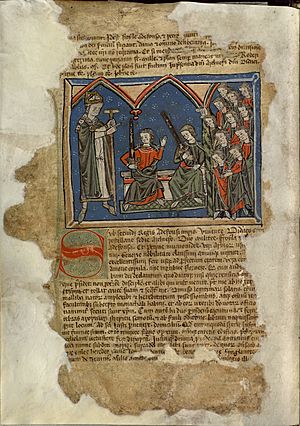Diego Gelmírez facts for kids
Diego Gelmírez (born around 1069, died around 1140) was a very important leader in the church and in the region of Galicia, which is in modern-day Spain. He started as a bishop in 1100 and later became the first archbishop of Santiago de Compostela in 1120.
Diego Gelmírez was a key figure in the history of Galicia. He was also a writer who recorded important events of his time in Iberia (the area where Spain and Portugal are today). He was involved in many disagreements, both with other church leaders and with rulers. These stories are told in a book called the Historia Compostelana. This book covers his time as a bishop from 1100 to 1139 and tells the story of his life.
Contents
Early Life and Becoming Bishop
Diego Gelmírez was probably born in a place called Catoira. His father, Gelmiro, was in charge of the castle there. Diego received his education at the court of King Alfonso VI, who ruled the kingdoms of León, Galicia, and Castile.
In 1092, Raymond, the Count of Galicia, chose Diego to be his secretary. By 1093, Diego was managing the church in Compostela. When the first bishop of Compostela, Dalmatius, died in 1095, the people asked the king to let Diego manage the church again. In 1099, the Pope allowed a new bishop to be chosen, and Diego was elected. He officially became the second bishop of Compostela in 1101.
During his time as bishop, King Alfonso gave Diego control over the city of Compostela. Diego worked hard to make Compostela a very important place for pilgrims traveling on the Way of St. James. He succeeded in this, making his church more famous and bringing many more pilgrims to Compostela.
Challenges and Power Struggles
In 1107, a powerful noble named Pedro Fróilaz de Traba rebelled against Queen Urraca and her new husband. Pedro was the guardian of the young heir, Alfonso Raimúndez. According to the Historia Compostelana, Diego Gelmírez and a knight named Arias Pérez led a group that opposed Pedro. Diego had agreed to lead this group in late 1109 or early 1110.
In 1110, a peace agreement between Pedro and Diego's group broke down. Pedro took over a fortress and put his wife and the young Alfonso there. Arias Pérez quickly surrounded the fortress. The people inside asked Diego to help them surrender. Diego did, but his own group became suspicious of him. When a deal was made, Arias had Diego, Pedro, and Alfonso all arrested! They were soon released in exchange for some castles. After this, Diego decided to join the group that wanted Galicia to be separate. In 1111, Diego crowned Alfonso Raimúndez as the King of Galicia, going against Queen Urraca and her husband.
Later in 1113, when the royal court was in Galicia, Arias Pérez tried to turn Queen Urraca against Diego. Urraca took away Diego's power over the city because the people wanted more rights for themselves. However, within a year, she gave him back his powers. She even said he didn't have to provide military service to the crown and gave him control over the entire church area.
Becoming Archbishop and Papal Legate
In 1120, Pope Callixtus II made Diego and his church even more important by making him an archbishop. The Pope also appointed him as a papal legate for Spain. This meant Diego was the Pope's special representative in Spain.
That same year, Queen Urraca ordered the important leaders of Galicia, including Arias Pérez, to promise their loyalty to Diego Gelmírez. They had to recognize him as "their lord, their patron, their king and their prince," while still being loyal to the queen.
However, in 1121, Diego made a new alliance with Pedro Fróilaz de Traba. This made his power seem like a threat to the queen. In the summer of 1121, Urraca had Diego arrested with the help of Arias Pérez. Diego was put in prison for a short time. But the people, whom he had worked hard to gain support from, demanded his release.
Around 1121, a man named Munio Peláez built an "illegal" castle near Compostela. The Historia Compostelana called it a "den of robbers and bandits." Diego managed to tear it down soon after it was built.
Later Years and Legacy
In the spring of 1126, after Queen Urraca died and Alfonso became king, Arias Pérez led another rebellion in Galicia. King Alfonso asked Diego Gelmírez and another leader to stop it. Diego surrounded Arias in a castle and forced him to surrender. Diego was very disappointed with Arias. He told him that if he continued his ways, he would lose his chance at eternal life.
Diego Gelmírez played a huge role in shaping the history of Galicia and making Santiago de Compostela a major center for pilgrims in medieval Europe.
See also
- In Spanish: Diego Gelmírez para niños


